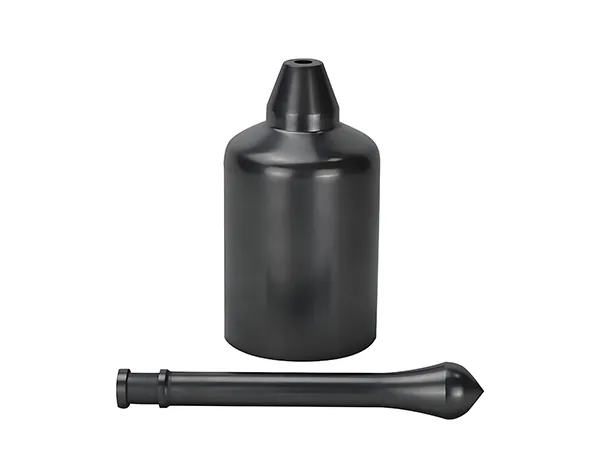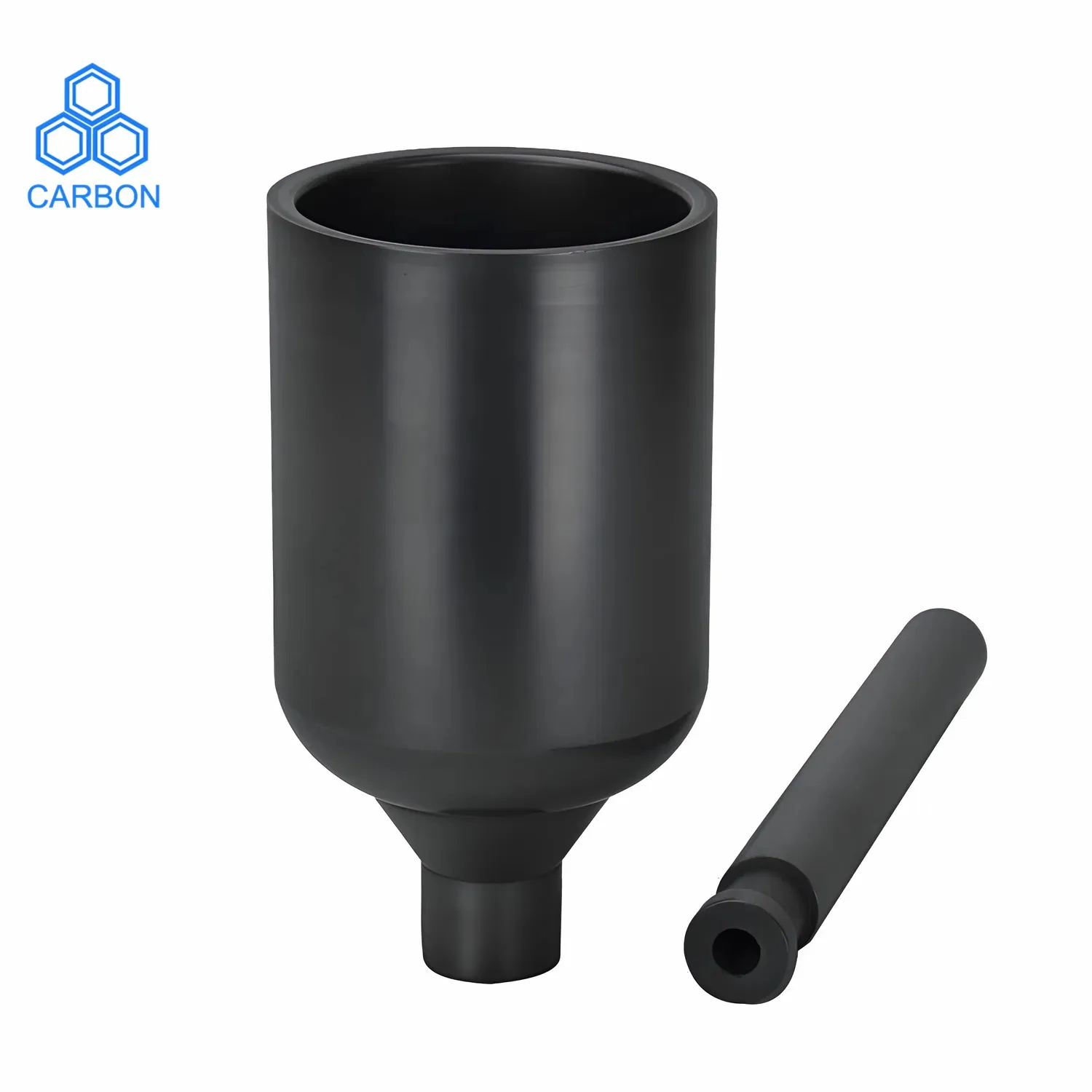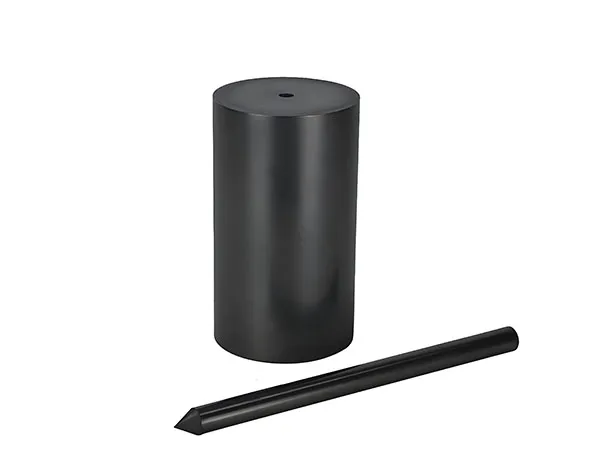Time: 2025-04-16 06:30:57 Source: Cangzhou Carbon Technology Co., Ltd.
Silicon carbide (SiC) crucibles and graphite crucibles are both used for high-temperature applications like melting metals, but they have significantly different properties, advantages, and disadvantages due to their distinct material compositions.

Silicon Carbide (SiC) Crucible: Made from silicon carbide, a hard ceramic compound of silicon and carbon (SiC). Often contains binders like clay (clay-bonded SiC) or silicon nitride (nitride-bonded SiC) to hold the SiC grains together.
Graphite Crucible: Made primarily from graphite, an allotrope of carbon. Can range from relatively low-purity amorphous carbon/graphite mixtures to high-purity isostatic graphite. May sometimes have clay binders as well, especially in lower-cost versions, or protective glazes.
SiC: Has good oxidation resistance up to high temperatures (typically ~1400-1650°C or 2550-3000°F, depending on the type and atmosphere). It forms a protective layer of silicon dioxide (SiO₂) in oxidizing atmospheres (like air), which slows down further oxidation. This is a major advantage over graphite for use in air.
Graphite: Has poor oxidation resistance. It begins to oxidize (burn away) in air at temperatures above ~500-600°C (932-1112°F). For high-temperature use, graphite crucibles require an inert atmosphere (like argon or nitrogen), a vacuum, or a protective coating/glaze to prevent rapid degradation.
SiC: Good thermal conductivity, allowing for reasonably fast heating.
Graphite: Excellent thermal conductivity, typically higher than SiC. This allows for very rapid and uniform heating of the contents.
SiC: Generally good thermal shock resistance, but can be more susceptible to cracking from rapid temperature changes than graphite, especially clay-bonded types.
Graphite: Excellent thermal shock resistance due to its high thermal conductivity and low thermal expansion coefficient. It can withstand rapid heating and cooling cycles very well.
SiC: Usable up to ~1650°C (3000°F) or slightly higher in controlled atmospheres, limited by oxidation in air above ~1400°C and the softening point of binders if present.
Graphite: Can withstand extremely high temperatures (sublimes >3600°C or >6500°F) but only in non-oxidizing atmospheres or vacuum. The practical limit is dictated by the atmosphere, not the material itself.

SiC: Relatively inert to many molten metals (especially non-ferrous like aluminum, copper alloys, zinc) and chemicals. However, it can react with molten iron (forming silicides) and highly basic slags or fluxes.
Graphite: Generally non-reactive with many molten metals (like gold, silver, aluminum) and non-oxidizing chemicals. However, it can react with carbide-forming metals (like iron, titanium) at high temperatures and can introduce carbon into the melt, which may be undesirable for certain alloys. Susceptible to attack by strong oxidizing agents.
SiC: Very hard, strong, and abrasion-resistant. More brittle than graphite.
Graphite: Much softer and less abrasion-resistant. Less brittle and more resistant to mechanical impact cracking (though it can chip). Its strength generally increases with temperature up to around 2500°C (in inert atmospheres).
SiC: Semiconductor. Its conductivity varies, but it's generally much lower than graphite.
Graphite: Excellent electrical conductor. This makes graphite crucibles ideal for direct induction heating, where the crucible itself acts as the heating element (susceptor).
SiC: Generally more expensive than standard graphite crucibles.
Graphite: Typically less expensive, although high-purity isostatic graphite can be costly.

|
Feature |
Silicon Carbide (SiC) Crucible |
Graphite Crucible |
Key Takeaway |
|
|
Material |
Silicon Carbide (ceramic) |
Carbon (graphite allotrope) |
Different base materials. |
|
|
Oxidation Resist. |
Good (up to ~1400-1650°C in air) |
Poor (oxidizes >500-600°C in air) |
SiC better for use in air. |
|
|
Thermal Conduct. |
Good |
Excellent |
Graphite heats faster/more evenly. |
|
|
Thermal Shock |
Good |
Excellent |
Graphite handles rapid temp changes better. |
|
|
Max Temp (Air) |
~1400-1650°C |
~500°C (limited by oxidation) |
SiC usable at much higher temps in air. |
|
|
Max Temp (Inert) |
|
>3000°C (material limit) |
Graphite has higher absolute temp limit if protected. |
|
|
Chemical React. |
Relatively inert, reacts w/ Fe, basic flux |
Inert w/ many metals, reacts w/ carbide formers, can add C |
Choice depends on melt chemistry. |
|
|
Hardness |
Very Hard |
Relatively Soft |
SiC more wear-resistant. |
|
|
Brittleness |
More Brittle |
Less Brittle |
Graphite less prone to impact fracture. |
|
|
Electrical Cond. |
Semiconductor |
Excellent Conductor |
Graphite ideal for direct induction heating. |
|
|
Cost |
Generally Higher |
Generally Lower |
Graphite often more economical initially. |
The choice between a silicon carbide and a graphite crucible depends heavily on the specific application:
Operating in an oxidizing atmosphere (air) at high temperatures (above 600°C).
Melting materials sensitive to carbon contamination.
High abrasion resistance is needed.
Melting reactive metals like iron is not the primary goal (or specific SiC types are used).
Operating in a vacuum or inert/reducing atmosphere.
Rapid heating via thermal conduction or direct induction heating is required.
Excellent thermal shock resistance is critical.
Carbon contamination of the melt is acceptable or desired.
Lower initial cost is a major factor.
Melting precious metals, aluminum (often with a wash), or for very high-temperature applications (>1700°C) in protected environments.